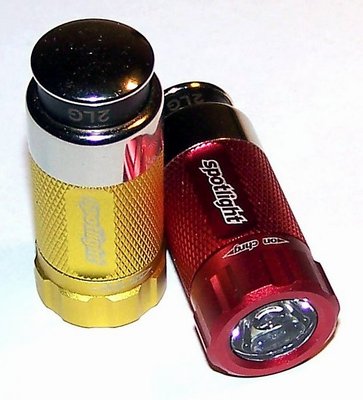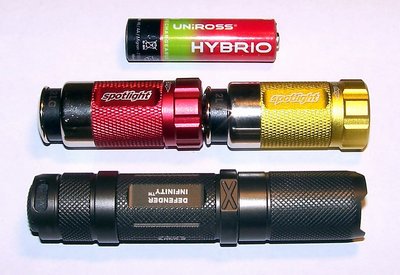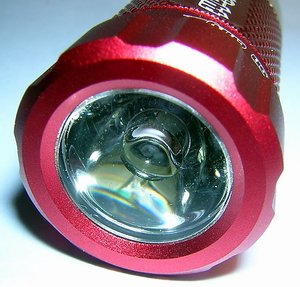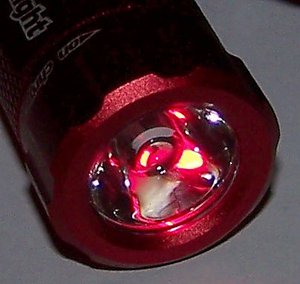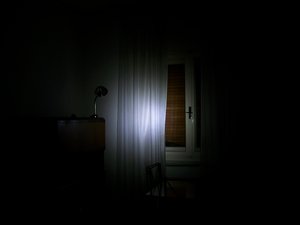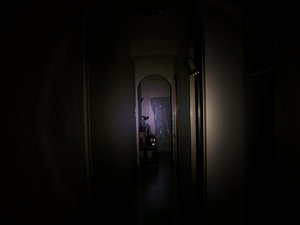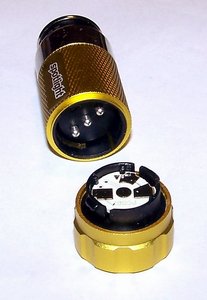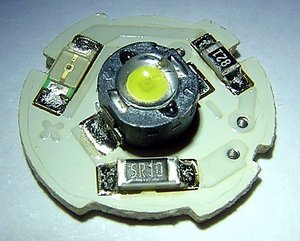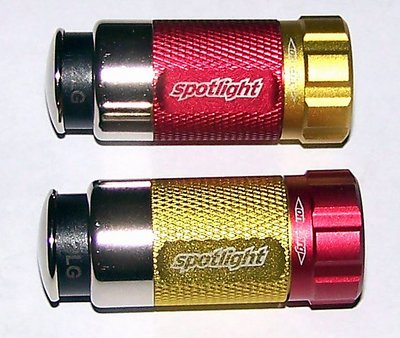TechNFun - Fun with technology
Electronic gadgets reviewed and modified
Reviewed on:
27th April 2008
Weiguo Solutions Spotlight
Rechargeable LED flashlight for the car
So, it's night and you've just blown a tire. You have a spare, but you have to remove the old tire first. So you start fumbling in the passenger compartment for the Maglite that you put in there years ago and never touched since, hoping its batteries still have some juice left in them and that your significant other, kids or friends didn't take it and never put it back.
Fast forward half an hour and, after having discovered your Maglite's batteries leaked long ago, or the bulb's blown, or the darn thing just won't turn on, or it's not even there, you're outside, trying to use a tire iron in the dark without losing the bolts while also trying not to cause bodily harm to yourself.
This rarely goes well.
It doesn't have to be that way, though.
Flashlights that take their power from the lighter socket have been around for ages. For the longest time all such lights were standard incandescent globes at the end of a long stretch of wire that had a car-lighter plug on the other end. You'd plug them in, trail the wire to where you needed the light, get tangled in it and make a mess.
Then someone had the idea of improving the design with rechargeable batteries. This worked, but such flashlights were rather large, and they still had incandescent bulbs.
Nowadays we have smaller rechargeable cells, and we also have LEDs, which are far more efficient than incandescent bulbs and thus naturally more suited to small batteries. There are various choices of 5mm-LED car-lighter flashlights, both with single emitters and arrays of them, but they tend to be either hopelessly dim or too bulky.
And then there's Weiguo Solutions' Spotlight.
The first thing you notice when you see a Spotlight is that it's small. It's only 5 centimetres (2 in) long, with a diameter of 2 cm (0.8 in) at its widest point.
If you position two head to tail, the result is only slightly longer and thicker than a 1AA flashlight (in this case my Nitecore Defender Infinity).
The second thing you notice is, obviously, the weird tailcap. It's not immediately clear to the uninitiated that it's meant to be stuck in a car lighter socket; it just looks like an ornate switch, or something.
Then you take it in your hand, and marvel at how light the thing is. My digital scale can't quite decide whether its weight is 32 or 33 grams; either way, if you put it in a normal pocket, you're very likely to forget you're carrying it.
The body is made of anodized aluminium, and it's quite aggressively knurled; this is good, because it makes the Spotlight easy to grip (doubly useful in a car environment, where you can easily get your hands dirty), but it'll chew up the finish on any object that repeatedly brushes against it. Don't put it in the same pocket where you keep your shiny new mobile phone.
The head isn't knurled, but it has ridges to facilitate operation of the twistie switch.
Turning the head clockwise turns the flashlight on. It's a simple on-off switch, with no multimode settings, and it's very reliable.
The Spotlight only charges when the switch is in the "CHG" position (head rotated counterclockwise). You can stick it in the lighter socket when it's turned on, but it'll just stay there draining its battery, taking no power at all from the car's electric system.
You can dunk a Spotlight in fresh water. It's not actually sealed, but it won't be hurt since all the parts inside are themselves sealed, and the circuitry is not elaborate enough to be damaged or shorted by water. Dry the light after use, don't leave it somewhere you mind getting wet, and it'll be fine. Note that it's not meant to be dunked in saltwater.
The LED is a Seoul Semiconductor unit. SSC are famous for making three-watt-nominal LEDs that rival Crees in output, but the one in the Spotlight is not a three watt unit; it's a lower power version, with a rating of a mere half watt.
So a Spotlight won't cause you to see purple blotches in your vision for several minutes if you blast yourself in the eyes with it, but it still makes far more light than you'd expect from its tiny size, and certainly more than enough for any task you might have to perform in, or around, a car.
The beam of the Spotlight is rather concentrated, as you might have guessed from its name. Most flashlights meant for utility use - rather than, say, security or military duty - tend to have orange peel reflectors that give them floody beams; flood is more useful than a tight hotspot when trying to figure out where the coins you just dropped went, or what part of your engine has suddenly decided leak tightness is no longer something it wants to be involved in.
Some lights meant strictly for utility duty don't even have any optics at all - you just get the bare emitter shining a broad pool of light in the general direction you're pointing the flashlight.
So why isn't the Spotlight like this, despite being very definitely a utility light?
Well, it's because it just doesn't have the power. The half-watt SSC LED is willing, and it's definitely far brighter than a standard 5mm LED, but it just doesn't have what it takes to throw a floody beam without sacrificing too many lumens.
Hence, this lens...
...which concentrates the beam enough to make it useful without completely giving up on flood.
When I first saw a picture of the Spotlight it seemed the sort of light that runs from a tiny Lithium-Ion cell, with microprocessor control and carefully controlled charge and discharge currents. But the spotlight only costs $15, which is about a fourth of what I'd expect a fancy regulated LiIon-powered flashlight of this size to cost.
What the Spotlight actually runs from is a small pack of three 80mAh nickel metal hydride cells, thicker than your average coin cell but much smaller than ordinary AAs, as seen in hand-cranked dynamo lights the world over.
And it has no electronic charge control. When you plug it in it just connects the battery to the socket through a voltage-dropping resistor and...
...this red LED. No, it's not bright enough to be used for anything - it's just a status indicator.
This means that when the Spotlight is sitting in the lighter socket on CHG, it never stops charging. NiMH cells don't much like this sort of treatment; NiCD is a far more suitable chemistry for float charging. But using NiCD cells in the Spotlight would have given truly pitiful runtimes, so NiMH it is.
This isn't as big a problem as you may think, because while NiMH cells don't like float charging they can stand it for surprisingly long times if the charging current is small enough. Just think of all the cordless phones that run on NiMH AAAs - they almost invariably float-charge them, and yet the cells last for years before they become too degraded to be useful.
When I connected the Spotlight to my laboratory power supply it drew 7mA from 12 volts. Cranking the voltage to 13.8V, which is what the Spotlight will see when the car's engine is running the alternator, upped the current draw to 11mA.
Some of this power is used to run the red LED, and some is dissipated by the resistor, so the current that the battery gets is trivially small. It takes about, oh, eight to twelve hours for the battery to go from flat to full.
This is definitely very little power, and it allows the battery to be float charged with relative impunity; you just have to accept the idea that you're going to have to replace the battery pack after a few years. Big deal - it's not like the tiny cells cost a million dollars, and they can be found relatively easily, either in specialist shops or by dismantling supercheap dynamo flashlights.
I disassembled a Spotlight and put a multimeter inbetween its lamp and its battery. From a resting voltage of 3.82V the lamp hauled the battery down to 3.5V, and drew about 65 mA in the process.
The Spotlight stays at close to full power for a bit less than an hour, but thanks to the simple resistored design it remains usable at lower brightness for a surprisingly long time after that. In an emergency situation you could probably get better-than-nothing light for as long as four hours, since the LED will keep running as long as the battery has enough voltage to fire it.
I wouldn't make a habit of this if I were you, though, because NiMH cells don't like being discharged too deep - anything under 1V hurts them. When the beam starts dimming noticeably it's time to stick the Spotlight back in the lighter socket.
Oh, and the NiMH battery will self-discharge even when not used. Don't expect to charge a Spotlight, leave it in a drawer for two months and come back to find it ready to use. This is not much of a problem, though, since the Spotlight is by its nature meant to be charged quite often.
The lighter socket in cars was originally meant to be used for lighters. Duh.
But the lighter socket is not a fully standardized connector. Different manufacturers have different ideas on how to make them; a given one may work perfectly for the lighter that was designed for it, but be pathetically unreliable with a number of gadgets - while being perfectly OK with others. It's a crapshoot, really.
A simple barrel socket, or any of a million of other standardized connectors, would be so much better for powering assorted gadgetry. But way back when the only electric device you could use in the car was the lighter, its socket was what came by default, and nobody had the idea of installing better connectors.
So when car gadgets started appearing the first manufacturers had no other choice but to use what was already available, and the others followed suit. Hence, lighter sockets used as generic power sources.
So will the Spotlight work in your socket?
I don't know.
What reports I've seen suggest that it works well in most sockets, and in those where it doesn't some wiggling it around often solves the problem. However, there is no such thing as a database of vehicles in which the Spotlight is proven to work, so you pretty much have to take the risk.
If it turns out that it doesn't work, not all is lost. There are adapters meant to let you plug in two or three gadgets into one socket. Find one that works on both the Spotlight and your car's socket and you're set. Weiguo themselves are going to start selling, at some undefined point in 2008, an adapter that plugs in the lighter socket and lets you use both a lighter and a Spotlight at the same time. It has a different plug than the flashlight itself, so there's a good chance it'll work in a socket that refuses a Spotlight.
Nowadays that getting cancer by means of practical little sticks is not as happy-go-lucky an activity as it once was, some manufacturers have taken to installing the socket only as an option. If you didn't ask for one and got a socket-less vehicle as a result, you're out of luck. Some manufacturers also offer, in place of or alongside to the ordinary lighter socket, one made specifically to run gadgets instead of lighters. Theoretically those should be less trouble-prone.
I encourage readers who buy a Spotlight to mail me and tell me what car they have and if they can use a Spotlight without adapters, and I'll add the results to this review.
The two Spotlights I received have slightly different beams. The red one is whiter but more, well, spotlight-y, while the yellow one's beam is slightly more floody but not as nice, with some yellowish artifacts.
| Manufacturers of more expensive flashlights often have "premium" versions with hand-picked near-perfect LEDs; you pay for the privilege, of course. They also sometimes have "factory second" versions, made with the LEDs that got discarded from regular production; you are more likely to get beam irregularities and colour variations, or machining imperfections, but the lights are considerably cheaper. |
Which one's better is a matter of personal preference. I like the red Spotlight's cleaner beam more, but the slightly floodier beam of the yellow one might be a bit more useful in a car environment. Then again, the change is so very small that it's unlikely to matter.
Officially all Spotlights are the same and their beams are, I think, meant to look like the red one's. These little differences are just what you get from mass production; the manufacturers build so many LEDs that some are bound to have tiny defects that alter their beams but that aren't significant enough to fail quality control.
I only took beamshots of the red Spotlight, as the difference is too small to notice in pictures.
At a distance of approximately one metre:
And here it is lighting up my living room and corridor:
As you can see, the hotspot is rather tight and there isn't much spill. There is a noticeable ring further out.
The Spotlight is pretty easy to take apart. Set the switch inbetween the charge and on positions, grab the body tight, and pull the head real hard.
Those three pins rotate against the contacts on the lamp module, and that's the entirety of the switching mechanism. Slide out the battery module by grabbing the pins with pliers (try not to be too rough), slide the battery out of it, then remove the lamp module from the head, and you've disassembled a Spotlight in its individual components:
There's not much hacking that can be done so far. You can replace the battery pack, but that's it.
Aha. These four components are all the circuitry in the Spotlight. The one in the center is (obviously) the main emitter; I guess a truly dedicated modder could replace it with a more powerful one, but there'd really be no point - the battery is way too weedy for anything more powerful than the LED that's already there.
The half-watt SSC (model number W92050C) is meant to draw 150mA at nominal power, but in order for the tiny battery to give decent runtimes it gets underdriven, courtesy of the resistor marked "5R10". The only real hack that comes to my mind is to replace that resistor with a less restrictive one; this would allow you to drive the LED at something closer to its nominal draw, at the price of a drastic decrease in runtimes. I leave to the reader the task of finding out what resistor is appropriate.
If you were feeling adventurous you could remove the resistor altogether and bridge its connection in order to direct-drive the LED, but that would be really unkind to both LED and battery. I certainly don't recommend doing this, and I make no guarantees that the poor SSC won't release the magic smoke if you decide to do it anyway.
The other two components are the charge resistor (the one marked "821") and the red charge LED.
There is, quite frankly, nothing I don't like about the Spotlight.
The one thing one could argue against is the tight beam, but at the current state of the technology you just can't make a tiny flashlight much more powerful than the Spotlight is without raising the price significantly and drastically decreasing runtimes.
Aside from that, the Spotlight excels at its job. It's very useful, it's unobtrusive, it's always ready when you need it, it's reliable and it's quite bright enough for most purposes.
In fact, I would totally understand if people bought it without actually owning a car. Get a 12V power supply like this one (or buy the official one whenever it becomes available, or just hack one up with any random 12V regulated adapter) and you have a general-purpose flashlight that's more than small enough to comfortably EDC and always ready to help whenever there's a power outage.
What are you doing still here? Go buy one!
Or you can buy two and let your silly creative side take over.
Heh heh.
